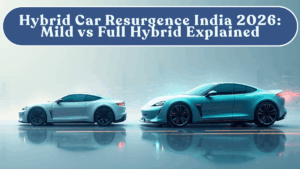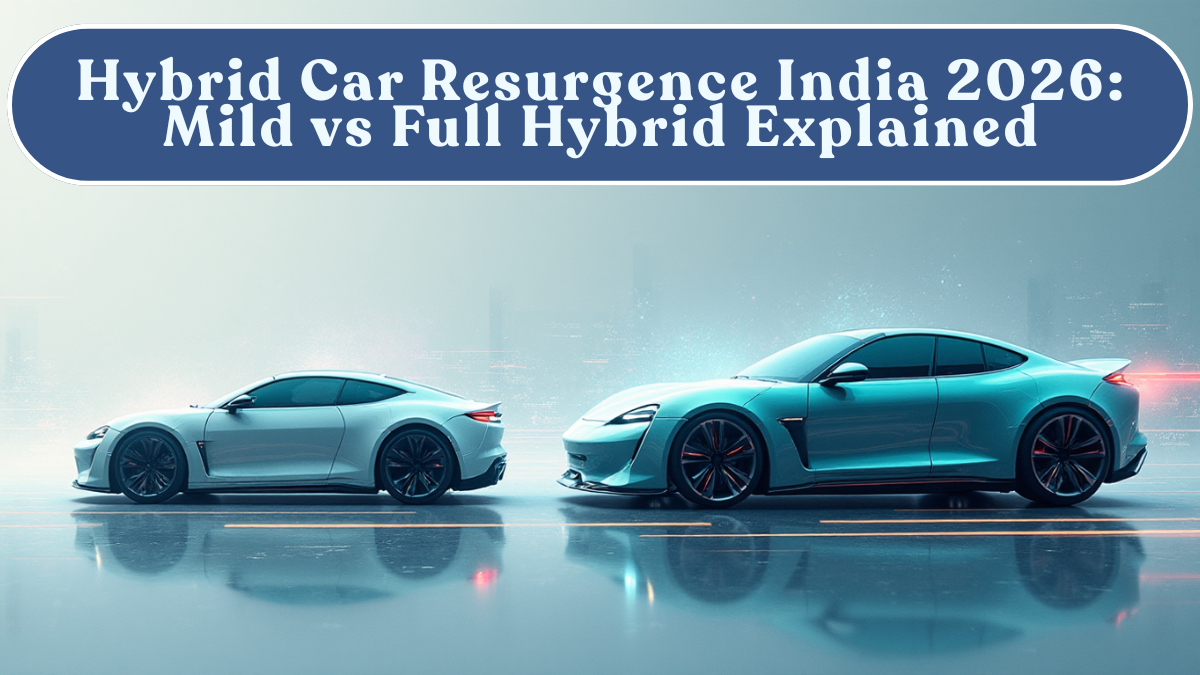As India’s automotive market accelerates toward electrification, 2026 is shaping up to be the year of the hybrid comeback. The hybrid car resurgence in India 2026 is driven by a combination of rising fuel prices, infrastructure gaps in EV charging, and government interest in transitional technologies.
While fully electric vehicles (EVs) grab the headlines, mild-hybrid and full-hybrid cars are quietly making a powerful return — offering improved mileage, reduced emissions, and greater practicality for Indian conditions. Let’s explore why hybrids are regaining popularity, how they differ, and which models are leading this new wave.

Why Hybrids Are Making a Comeback
In 2025, India’s EV penetration remains under 3% of total car sales, limited by high costs and patchy charging infrastructure. This gap has opened doors for hybrid vehicles as the perfect bridge between petrol and electric mobility.
Manufacturers like Maruti Suzuki, Toyota, and Honda are expanding their hybrid lineups to tap into demand for fuel-efficient, low-maintenance options. Additionally, the Union Ministry of Heavy Industries is reportedly revisiting tax incentives for hybrids in the 2025–26 budget, recognising their potential to reduce oil dependency.
Verdict: Hybrids are emerging as India’s practical green solution — efficient, affordable, and infrastructure-ready.
Mild Hybrid vs Full Hybrid: The Key Difference
Before diving into models and performance, it’s important to understand the distinction between mild-hybrid and full-hybrid systems.
| Type | Power Source | Key Feature | Fuel Savings | Price Impact |
|---|---|---|---|---|
| Mild Hybrid (MHEV) | Engine + 48V Battery | Assists engine during acceleration | 10–15% better efficiency | Low (₹50k–₹1 lakh more) |
| Full Hybrid (HEV) | Engine + Electric Motor | Can run short distances on battery alone | 25–35% better efficiency | Moderate (₹1.5–₹3 lakh more) |
Mild-hybrids use small batteries to assist the petrol engine but cannot operate independently. Full-hybrids, on the other hand, can switch between petrol and electric drive modes, offering near-EV mileage in city conditions.
Verdict: Mild-hybrids are budget-friendly and ideal for mass buyers, while full-hybrids deliver superior efficiency and lower emissions.
The Leading Hybrid Cars in India (2026 Lineup)
India’s hybrid car portfolio is set to expand rapidly in 2026, covering sedans, SUVs, and premium crossovers.
| Model | Type | Powertrain | Mileage (km/l) | Expected Price (₹) |
|---|---|---|---|---|
| Toyota Innova HyCross | Full Hybrid | 2.0L + e-Drive | 23.2 | ₹25–33 lakh |
| Maruti Grand Vitara Hybrid | Full Hybrid | 1.5L + Motor | 27.9 | ₹18–23 lakh |
| Honda City e:HEV | Full Hybrid | 1.5L i-MMD | 26.5 | ₹20–22 lakh |
| Hyundai Creta Hybrid (2026) | Mild Hybrid | 1.5L Turbo + 48V | 20.0 | ₹17–21 lakh |
| Mahindra XUV700 Hybrid (Upcoming) | Mild Hybrid | 2.0L Petrol + 48V | 18.5 | ₹20–24 lakh |
Manufacturers are also exploring flex-fuel-hybrid combinations, allowing vehicles to run on ethanol blends while maintaining hybrid efficiency.
Verdict: Expect hybrids across every segment — from urban sedans to large family SUVs — by mid-2026.
Performance and Efficiency
Full-hybrid systems like those in the Grand Vitara and City e:HEV operate seamlessly between engine and electric drive, achieving impressive fuel economy. These cars start in EV mode, use petrol during high-speed runs, and regenerate energy during braking.
Mild-hybrids, meanwhile, use a belt starter generator (BSG) for smoother start-stop operation and torque boost during acceleration. While they can’t run solely on electricity, they offer noticeable fuel savings in traffic-heavy Indian cities.
Verdict: Full-hybrids shine in stop-and-go urban conditions, while mild-hybrids deliver real benefits for mixed highway driving.
Battery and Maintenance
One major reason hybrids appeal to Indian buyers is their low-maintenance nature compared to pure EVs. Hybrid batteries are self-charging, relying on regenerative braking rather than external charging infrastructure.
Battery lifespan averages 8–10 years, with most manufacturers offering 8-year/160,000 km warranty. Replacement costs have also come down significantly — to around ₹70,000–₹1.2 lakh for mild-hybrid systems and ₹1.5–₹2.5 lakh for full-hybrids.
Verdict: Hybrids offer long battery life and minimal maintenance, ideal for cost-conscious Indian drivers.
Government Policy and Incentives
The Indian government’s EV-first focus is now evolving to include hybrid technologies. Policymakers are recognising that hybrids can accelerate carbon reduction while EV infrastructure matures.
As of late 2025, discussions are underway for:
-
GST reduction on hybrids from 28% to 18%
-
Lower road tax for full-hybrids
-
Inclusion in FAME-III benefits for domestic hybrid production
If implemented, these measures could make hybrids 10–15% cheaper in 2026, boosting sales volumes significantly.
Verdict: Policy support could turn hybrids into the mainstream green mobility solution in 2026.
Driving Experience and Practicality
Modern hybrids are engineered to deliver quiet, refined drives. The electric motor handles low-speed city traffic, while the petrol engine kicks in smoothly at higher speeds. Noise levels remain low, and transitions between modes are almost imperceptible.
In India’s congested cities, this translates to superior comfort, higher mileage, and fewer gear shifts. Many hybrid models also come with drive modes (Eco, Normal, Power) that adjust throttle and energy use dynamically.
Verdict: Smooth, silent, and responsive — hybrids offer a premium driving experience suited for Indian conditions.
Challenges Ahead
Despite growing popularity, hybrids still face hurdles:
-
Higher upfront cost than non-hybrid petrol variants
-
Limited awareness among rural buyers
-
Import dependence for key hybrid components
However, with increased localisation and policy backing, these challenges are expected to diminish by late 2026.
Verdict: Initial cost remains the only major drawback — offset by long-term fuel savings and lower emissions.
Final Verdict
The hybrid car resurgence in India 2026 marks a crucial turning point in India’s journey toward sustainable mobility. With EVs still building momentum, hybrids fill the gap with their balanced performance, strong mileage, and familiar convenience.
As more models arrive across price points and government policies evolve, hybrids are set to become a key pillar of India’s green automotive future.
Overall Verdict: Hybrids are India’s bridge to electrification — efficient, reliable, and ready for widespread adoption by 2026.
FAQs
Why are hybrid cars gaining popularity again in India?
Because they offer better mileage and lower emissions without requiring EV charging infrastructure.
What is the main difference between mild and full hybrids?
Mild-hybrids assist the petrol engine, while full-hybrids can run independently on electric power for short distances.
Do hybrids need external charging?
No, all hybrids are self-charging, using regenerative braking and engine power.
What are the most popular hybrid cars in India?
The Maruti Grand Vitara Hybrid, Toyota HyCross, and Honda City e:HEV lead the 2026 hybrid lineup.
Will hybrid cars get government subsidies in 2026?
Yes, proposed GST reductions and FAME-III benefits may make hybrids cheaper in 2026.
Are hybrid cars worth buying in India?
Absolutely — they offer the perfect blend of efficiency, performance, and convenience for Indian driving conditions.
Click here to know more.
